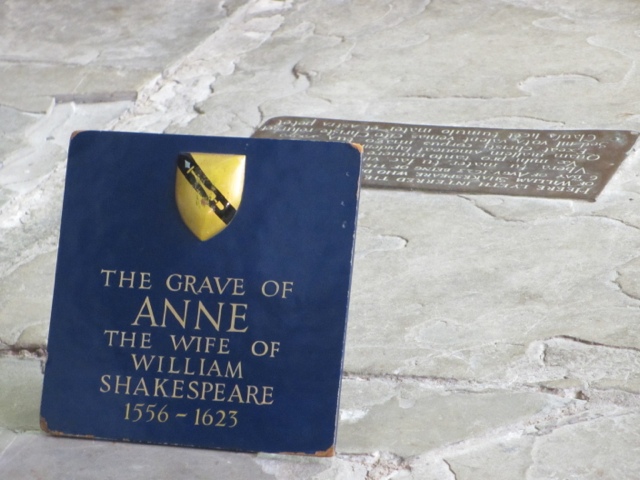We made our first stop of the day at Stratford Upon Avon, the home of William Shakespeare and also the home of his wife , Anne Hathaway. We saw the house where he was born, his wife's home and the church where they are buried.
William Shakespeare married when he was 18 years old to a woman , Anne Hathaway, who was 26 ( a veritable spinster in those days)! Anne was three months pregnant (against the law in those days) so they were quickly married in 1581. It is likely that they knew each other growing up and that their families were good friends. Shakespeare's father was the Mayor of Stratford and once co-signed on a loan for the Harhaways that would be the equivalent of 4,000 pounds today. Clearly the families were close.
Because Shakespeare's father would have had to give out the licenses for traveling theater troups to perform, Shakespeare became well acquainted with the traveling actors. After he married Anne, they had three children in three years-- a set of twins and one other daughter. Shakespeare left Stratford for a period of years and went to London. He hoped to be an actor , but found his talents lay In Writing, not acting. He became quite wealthy as his plays became a success and he was a part owner in the famed Globe Theater. He eventually returned to Stratford and built a new home. He died at the ripe old age of 52 and was buried in 1616 at the Holy Trinity Church in Stratford Upon Avon. His wife Anne is also buried in the church. His plays were gathered by two of his friends and bound into a folio. It is only because they did this as a tribute to their good friend that we have a record of his works. Otherwise, the individual plays would have been scattered everywhere.
Here are some interesting phrases and origins of words we learned. But first, I want to mention that the first cause of death for women in the 1400's was childbirth, BUT the second cause of death was fire. Women's war was carried on in the kitchen. They dressed in long skirts with linen petticoats and were required to keep the fire burning all day! Unfortunately, some would become human torches! But, it was the LAW that they must keep the fire going during the daylight hours. If they let the fire go out , the husband was allowed to beat the wife (daytime hours only so as not to wake the neighbors with her screams) with a stick that had to be smaller than the thickness of his thumb! It was a matter of life and death for the husband because if he came home wet and cold and there was no fire to get him warm, he might literally catch his "death of cold"! The word curfew comes from a ceramic covering that was like a large piece of furniture that had to be placed over the fire at night to "dampen the fire". The fire was not allowed to burn brightly at night for fear sparks might set the thatched roofs on fire.. So, the "curfew" was placed over the fire at night to keep embers glowing, but not burning brightly. The phrase "bed and board" comes from the fact that a board was placed on trestles as the dining table but after dinner, the board was turned over and laid on the floor as a bed! To "sleep tight and don't let the bed bugs bite" comes from the fact that ropes had to constantly be tightened to hold the mattress firmly. There was a canopy over the beds to keep any insects from falling Into the open mouths of those sleeping! The phrase "letting your hair down" comes from the coronation of Elizabeth the First who was crowned with her flowing red hair loose and down. Prior to that, women always kept their hair up. She made it fashionable to "let your hair down!"
After touring Anne Hathaway's and Shakespeare's homes, and viewing the lovely gardens, we headed for Warwick Castle! They have done a very good job of recreating scenes in the castle. Madame Tussaud's did the wax characters that are EXTREMELY lifelike as you will see in the photos! Warwick Castle was first built by William the Conqueror in 1088. There proceeded to be a LOT of different owners after that ( about 43).
We were treated to a falconry show on the grounds of the castle. We saw an owl fly in for food. There was a bald eagle who would fly to the top of the castle and then swoop back down for a piece of chicken from the handler. There was another eagle whose type I do not recall, but he too flies to the top of the castle and then comes back to retrieve his snack of chicken! It started to mist rather heavily as the afternoon wore on. It did little to dampen our spirits. After returning to our lovely hotel in Chipping (means barter in old English ) Campden, we took a break to begin a little packing before heading out to Eight Bells Pub for a delicious dinner! Gaby again delighted us all by handing out her collection of stickers! We've now learned to "recycle" them!
Our guide, Debbie is just wonderful. She is very knowledgeable and keeps us all entertained and amazed with her extensive knowledge! More tomorrow! We will see more Cotswold Villages in the morning with a trip to Bath in the afternoon where we will see the Roman Baths! Stay tuned!
Gaby is next to a stone that looks like a large mushroom. In fact, there used to be a lot of these stones upon which barns were built. The stone mushrooms kept the rats from climbing into the barns!


































You taught all of us lessons.
ReplyDeleteGreat blog